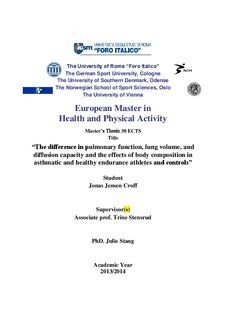The difference in pulmonary function, lung volume, and diffusion capacity and the effects of body composition in asthmatic and healthy endurance athletes and controls
Abstract
Background: Elite endurance athletes who daily exercise in unfavorable environments such as cold or polluted air is in increased risk for developing asthma. However, endurance athletes are reported to have greater pulmonary function and lung volumes compared to non-athletes. Mechanisms behind the observed differences are unclear. Fat and muscle mass are believed to affect pulmonary function in obese subjects, but the association in athletes is not known. Objective: The main objective was to compare pulmonary function, lung volume and diffusion capacity (DLco) between endurance athletes with/without self-reported asthma competing within cross-country skiing and swimming and healthy controls. The second objective was to investigate the possible association between body mass index and body composition upon pulmonary function in the same population. Methods: An observational case-control study was conducted with 25 asthmatic endurance athletes, 37 healthy endurance athletes, and 27 healthy non-athlete controls. Pulmonary function was measured by spirometry. Body plethysmography was used to measure lung volumes and the single breath method was used to measure diffusion capacity (DLco). Body composition was measured with Inbody 720, bio-electrical impedance analysis. Results: The healthy athletes had significantly higher pulmonary function (FEV1, MVV) and DLco compared to controls. No differences were observed between asthmatic athletes and healthy athletes or asthmatic athletes and controls. Fat-mass had a significant negative association to DLco. Muscle mass had a significant positive association to DLco. Conclusion: The findings from the present study show that healthy endurance athletes have superior pulmonary function and diffusion capacity compared to controls. No differences were observed between asthmatic athletes and healthy athletes or asthmatic athletes and controls. Diffusion capacity has a significant association to fat and muscle mass in the same population.
Description
Masteroppgave - Norges idrettshøgskole, 2014
